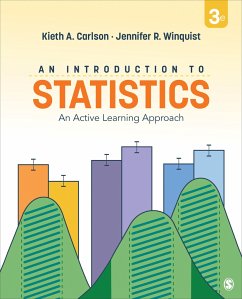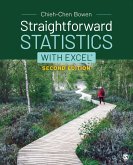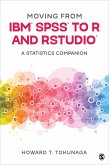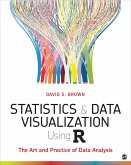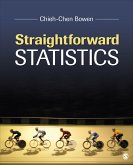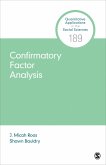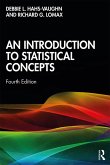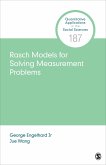- Broschiertes Buch
- Merkliste
- Auf die Merkliste
- Bewerten Bewerten
- Teilen
- Produkt teilen
- Produkterinnerung
- Produkterinnerung
This updated and reorganized Third Edition of this textbook takes a workbook-style approach that encourages an active approach to learning statistics. Carefully placed reading questions throughout each chapter allow students to apply their knowledge right away.
Andere Kunden interessierten sich auch für
![Straightforward Statistics with Excel Straightforward Statistics with Excel]() Chieh-Chen BowenStraightforward Statistics with Excel136,99 €
Chieh-Chen BowenStraightforward Statistics with Excel136,99 €![Moving from Ibm(r) Spss(r) to R and Rstudio(r) Moving from Ibm(r) Spss(r) to R and Rstudio(r)]() Howard T. TokunagaMoving from Ibm(r) Spss(r) to R and Rstudio(r)50,99 €
Howard T. TokunagaMoving from Ibm(r) Spss(r) to R and Rstudio(r)50,99 €![Statistics and Data Visualization Using R Statistics and Data Visualization Using R]() David S. S. Brown (University of Colorado, Boulder, USA)Statistics and Data Visualization Using R184,99 €
David S. S. Brown (University of Colorado, Boulder, USA)Statistics and Data Visualization Using R184,99 €![Straightforward Statistics Straightforward Statistics]() Chieh-Chen BowenStraightforward Statistics164,99 €
Chieh-Chen BowenStraightforward Statistics164,99 €![Confirmatory Factor Analysis Confirmatory Factor Analysis]() J. Micah Roos (Virginia Polytechnic Institute and State UniversityConfirmatory Factor Analysis55,99 €
J. Micah Roos (Virginia Polytechnic Institute and State UniversityConfirmatory Factor Analysis55,99 €![An Introduction to Statistical Concepts An Introduction to Statistical Concepts]() Debbie L. Hahs-VaughnAn Introduction to Statistical Concepts127,99 €
Debbie L. Hahs-VaughnAn Introduction to Statistical Concepts127,99 €![Rasch Models for Solving Measurement Problems Rasch Models for Solving Measurement Problems]() Engelhard, George, Jr.Rasch Models for Solving Measurement Problems40,99 €
Engelhard, George, Jr.Rasch Models for Solving Measurement Problems40,99 €-
-
-
This updated and reorganized Third Edition of this textbook takes a workbook-style approach that encourages an active approach to learning statistics. Carefully placed reading questions throughout each chapter allow students to apply their knowledge right away.
Hinweis: Dieser Artikel kann nur an eine deutsche Lieferadresse ausgeliefert werden.
Hinweis: Dieser Artikel kann nur an eine deutsche Lieferadresse ausgeliefert werden.
Produktdetails
- Produktdetails
- Verlag: SAGE Publications Inc
- 3 Revised edition
- Seitenzahl: 512
- Erscheinungstermin: 3. Februar 2021
- Englisch
- Abmessung: 231mm x 183mm x 25mm
- Gewicht: 920g
- ISBN-13: 9781544375090
- ISBN-10: 1544375093
- Artikelnr.: 60906486
- Herstellerkennzeichnung
- Libri GmbH
- Europaallee 1
- 36244 Bad Hersfeld
- gpsr@libri.de
- Verlag: SAGE Publications Inc
- 3 Revised edition
- Seitenzahl: 512
- Erscheinungstermin: 3. Februar 2021
- Englisch
- Abmessung: 231mm x 183mm x 25mm
- Gewicht: 920g
- ISBN-13: 9781544375090
- ISBN-10: 1544375093
- Artikelnr.: 60906486
- Herstellerkennzeichnung
- Libri GmbH
- Europaallee 1
- 36244 Bad Hersfeld
- gpsr@libri.de
Kieth A. Carlson received his PhD in Experimental Psychology with an emphasis in Cognitive Psychology from the University of Nebraska in 1996. He is currently Professor of Psychology at Valparaiso University. He has published research on visual attention, memory, student cynicism toward college, and active learning. He enjoys teaching a wide range of courses including statistics, research methods, sensation and perception, cognitive psychology, learning psychology, the philosophy of science, and the history of psychology. Dr. Carlson was twice honored with the Teaching Excellence Award from the United States Air Force Academy.
Preface
Acknowledgments
About the Authors
Part 1: Descriptive Statistics and Sampling Error
Chapter 1: Introduction to Statistics and Frequency Distributions
How to Be Successful in This Course
Math Skills Required in This Course
Statistical Software Options
Why Do You Have to Take Statistics?
The Four Pillars of Scientific Reasoning
Populations and Samples
Independent and Dependent Variables
Identify How a Variable Is Measured
Graphing Data
Shapes of Distributions
Frequency Distribution Tables
Chapter 2: Central Tendency and Variability
Frequency Distribution Graphs and Tables
Central Tendency: Choosing Mean, Median, or Mode
Computing Measures of Central Tendency
Variability: Range or Standard Deviation
Steps in Computing a Population's Standard Deviation
Steps in Computing a Sample's Standard Deviation
Constructing a Scientific Conclusion
Chapter 3: z scores
Computing and Interpreting z for a Raw Score
Finding Raw Score "Cut Lines"
Finding the Probability of z Scores Using the Standard Normal Curve
Positive z Score Example
Negative z Score Example
Proportion Between Two z Scores Example
Chapter 4: Sampling Error and Confidence Intervals with z and t
Distributions
Sampling and Sampling Error
The Central Limit Theorem and the Standard Error of the Mean (SEM)
Applying the SEM to Find Statistical Evidence
Part 2: Applying the Four Pillars of Scientific Reasoning to Mean
Differences
Chapter 5: Single sample t, effect sizes, and confidence intervals
Four Pillars of Scientific Reasoning
Apply the Four Pillars of Scientific Reasoning
Construct a Well-Supported Scientific Conclusion
Chapter 6: Related samples t, effect sizes, and confidence intervals
Related Samples t Test
Logic of the Single Sample and Related Samples t Tests
Apply the Four Pillars of Scientific Reasoning
Construct a Well-Supported Scientific Conclusion
Chapter 7: Independent samples t, effect sizes, and confidence intervals
When to Use the Three t Tests
The t Test Logic and the Independent Samples t Formula
Apply the Four Pillars of Scientific Reasoning
Construct a Well-Supported Scientific Conclusion
How to Interpret High p Values
Chapter 8: One-way ANOVA, effect sizes, and confidence intervals
Independent Samples One-Way ANOVA
Logic of the ANOVA
Apply Four Pillars of Scientific Reasoning
Chapter 9: Two-way ANOVA, effect sizes, and confidence intervals
Purpose of Two-Way ANOVA
Logic of Two-Way ANOVA
Apply Four Pillars of Scientific Reasoning
Part 3: Applying the Four Pillars of Scientific Reasoning to Associations
Chapter 10: Correlations, effect sizes, and confidence intervals
When to Use Correlations
The Logic of Correlation
Interpreting Correlation Coefficients
Spearman's (rs) Correlation
Correlation Does Not Equal Causation: True but Misleading
Apply the Four Pillars of Scientific Reasoning
Construct a Well-Supported Scientific Conclusion
Chapter 11: Chi square and effect sizes
When to Use X2 Statistics
Logic of the X2 Test
Apply the Pillars of Scientific Reasoning
Construct a Well-Supported Scientific Conclusion
Apply the Pillars of Scientific Reasoning: X2 for Independence
Appendices
References
Index
Acknowledgments
About the Authors
Part 1: Descriptive Statistics and Sampling Error
Chapter 1: Introduction to Statistics and Frequency Distributions
How to Be Successful in This Course
Math Skills Required in This Course
Statistical Software Options
Why Do You Have to Take Statistics?
The Four Pillars of Scientific Reasoning
Populations and Samples
Independent and Dependent Variables
Identify How a Variable Is Measured
Graphing Data
Shapes of Distributions
Frequency Distribution Tables
Chapter 2: Central Tendency and Variability
Frequency Distribution Graphs and Tables
Central Tendency: Choosing Mean, Median, or Mode
Computing Measures of Central Tendency
Variability: Range or Standard Deviation
Steps in Computing a Population's Standard Deviation
Steps in Computing a Sample's Standard Deviation
Constructing a Scientific Conclusion
Chapter 3: z scores
Computing and Interpreting z for a Raw Score
Finding Raw Score "Cut Lines"
Finding the Probability of z Scores Using the Standard Normal Curve
Positive z Score Example
Negative z Score Example
Proportion Between Two z Scores Example
Chapter 4: Sampling Error and Confidence Intervals with z and t
Distributions
Sampling and Sampling Error
The Central Limit Theorem and the Standard Error of the Mean (SEM)
Applying the SEM to Find Statistical Evidence
Part 2: Applying the Four Pillars of Scientific Reasoning to Mean
Differences
Chapter 5: Single sample t, effect sizes, and confidence intervals
Four Pillars of Scientific Reasoning
Apply the Four Pillars of Scientific Reasoning
Construct a Well-Supported Scientific Conclusion
Chapter 6: Related samples t, effect sizes, and confidence intervals
Related Samples t Test
Logic of the Single Sample and Related Samples t Tests
Apply the Four Pillars of Scientific Reasoning
Construct a Well-Supported Scientific Conclusion
Chapter 7: Independent samples t, effect sizes, and confidence intervals
When to Use the Three t Tests
The t Test Logic and the Independent Samples t Formula
Apply the Four Pillars of Scientific Reasoning
Construct a Well-Supported Scientific Conclusion
How to Interpret High p Values
Chapter 8: One-way ANOVA, effect sizes, and confidence intervals
Independent Samples One-Way ANOVA
Logic of the ANOVA
Apply Four Pillars of Scientific Reasoning
Chapter 9: Two-way ANOVA, effect sizes, and confidence intervals
Purpose of Two-Way ANOVA
Logic of Two-Way ANOVA
Apply Four Pillars of Scientific Reasoning
Part 3: Applying the Four Pillars of Scientific Reasoning to Associations
Chapter 10: Correlations, effect sizes, and confidence intervals
When to Use Correlations
The Logic of Correlation
Interpreting Correlation Coefficients
Spearman's (rs) Correlation
Correlation Does Not Equal Causation: True but Misleading
Apply the Four Pillars of Scientific Reasoning
Construct a Well-Supported Scientific Conclusion
Chapter 11: Chi square and effect sizes
When to Use X2 Statistics
Logic of the X2 Test
Apply the Pillars of Scientific Reasoning
Construct a Well-Supported Scientific Conclusion
Apply the Pillars of Scientific Reasoning: X2 for Independence
Appendices
References
Index
Preface
Acknowledgments
About the Authors
Part 1: Descriptive Statistics and Sampling Error
Chapter 1: Introduction to Statistics and Frequency Distributions
How to Be Successful in This Course
Math Skills Required in This Course
Statistical Software Options
Why Do You Have to Take Statistics?
The Four Pillars of Scientific Reasoning
Populations and Samples
Independent and Dependent Variables
Identify How a Variable Is Measured
Graphing Data
Shapes of Distributions
Frequency Distribution Tables
Chapter 2: Central Tendency and Variability
Frequency Distribution Graphs and Tables
Central Tendency: Choosing Mean, Median, or Mode
Computing Measures of Central Tendency
Variability: Range or Standard Deviation
Steps in Computing a Population's Standard Deviation
Steps in Computing a Sample's Standard Deviation
Constructing a Scientific Conclusion
Chapter 3: z scores
Computing and Interpreting z for a Raw Score
Finding Raw Score "Cut Lines"
Finding the Probability of z Scores Using the Standard Normal Curve
Positive z Score Example
Negative z Score Example
Proportion Between Two z Scores Example
Chapter 4: Sampling Error and Confidence Intervals with z and t
Distributions
Sampling and Sampling Error
The Central Limit Theorem and the Standard Error of the Mean (SEM)
Applying the SEM to Find Statistical Evidence
Part 2: Applying the Four Pillars of Scientific Reasoning to Mean
Differences
Chapter 5: Single sample t, effect sizes, and confidence intervals
Four Pillars of Scientific Reasoning
Apply the Four Pillars of Scientific Reasoning
Construct a Well-Supported Scientific Conclusion
Chapter 6: Related samples t, effect sizes, and confidence intervals
Related Samples t Test
Logic of the Single Sample and Related Samples t Tests
Apply the Four Pillars of Scientific Reasoning
Construct a Well-Supported Scientific Conclusion
Chapter 7: Independent samples t, effect sizes, and confidence intervals
When to Use the Three t Tests
The t Test Logic and the Independent Samples t Formula
Apply the Four Pillars of Scientific Reasoning
Construct a Well-Supported Scientific Conclusion
How to Interpret High p Values
Chapter 8: One-way ANOVA, effect sizes, and confidence intervals
Independent Samples One-Way ANOVA
Logic of the ANOVA
Apply Four Pillars of Scientific Reasoning
Chapter 9: Two-way ANOVA, effect sizes, and confidence intervals
Purpose of Two-Way ANOVA
Logic of Two-Way ANOVA
Apply Four Pillars of Scientific Reasoning
Part 3: Applying the Four Pillars of Scientific Reasoning to Associations
Chapter 10: Correlations, effect sizes, and confidence intervals
When to Use Correlations
The Logic of Correlation
Interpreting Correlation Coefficients
Spearman's (rs) Correlation
Correlation Does Not Equal Causation: True but Misleading
Apply the Four Pillars of Scientific Reasoning
Construct a Well-Supported Scientific Conclusion
Chapter 11: Chi square and effect sizes
When to Use X2 Statistics
Logic of the X2 Test
Apply the Pillars of Scientific Reasoning
Construct a Well-Supported Scientific Conclusion
Apply the Pillars of Scientific Reasoning: X2 for Independence
Appendices
References
Index
Acknowledgments
About the Authors
Part 1: Descriptive Statistics and Sampling Error
Chapter 1: Introduction to Statistics and Frequency Distributions
How to Be Successful in This Course
Math Skills Required in This Course
Statistical Software Options
Why Do You Have to Take Statistics?
The Four Pillars of Scientific Reasoning
Populations and Samples
Independent and Dependent Variables
Identify How a Variable Is Measured
Graphing Data
Shapes of Distributions
Frequency Distribution Tables
Chapter 2: Central Tendency and Variability
Frequency Distribution Graphs and Tables
Central Tendency: Choosing Mean, Median, or Mode
Computing Measures of Central Tendency
Variability: Range or Standard Deviation
Steps in Computing a Population's Standard Deviation
Steps in Computing a Sample's Standard Deviation
Constructing a Scientific Conclusion
Chapter 3: z scores
Computing and Interpreting z for a Raw Score
Finding Raw Score "Cut Lines"
Finding the Probability of z Scores Using the Standard Normal Curve
Positive z Score Example
Negative z Score Example
Proportion Between Two z Scores Example
Chapter 4: Sampling Error and Confidence Intervals with z and t
Distributions
Sampling and Sampling Error
The Central Limit Theorem and the Standard Error of the Mean (SEM)
Applying the SEM to Find Statistical Evidence
Part 2: Applying the Four Pillars of Scientific Reasoning to Mean
Differences
Chapter 5: Single sample t, effect sizes, and confidence intervals
Four Pillars of Scientific Reasoning
Apply the Four Pillars of Scientific Reasoning
Construct a Well-Supported Scientific Conclusion
Chapter 6: Related samples t, effect sizes, and confidence intervals
Related Samples t Test
Logic of the Single Sample and Related Samples t Tests
Apply the Four Pillars of Scientific Reasoning
Construct a Well-Supported Scientific Conclusion
Chapter 7: Independent samples t, effect sizes, and confidence intervals
When to Use the Three t Tests
The t Test Logic and the Independent Samples t Formula
Apply the Four Pillars of Scientific Reasoning
Construct a Well-Supported Scientific Conclusion
How to Interpret High p Values
Chapter 8: One-way ANOVA, effect sizes, and confidence intervals
Independent Samples One-Way ANOVA
Logic of the ANOVA
Apply Four Pillars of Scientific Reasoning
Chapter 9: Two-way ANOVA, effect sizes, and confidence intervals
Purpose of Two-Way ANOVA
Logic of Two-Way ANOVA
Apply Four Pillars of Scientific Reasoning
Part 3: Applying the Four Pillars of Scientific Reasoning to Associations
Chapter 10: Correlations, effect sizes, and confidence intervals
When to Use Correlations
The Logic of Correlation
Interpreting Correlation Coefficients
Spearman's (rs) Correlation
Correlation Does Not Equal Causation: True but Misleading
Apply the Four Pillars of Scientific Reasoning
Construct a Well-Supported Scientific Conclusion
Chapter 11: Chi square and effect sizes
When to Use X2 Statistics
Logic of the X2 Test
Apply the Pillars of Scientific Reasoning
Construct a Well-Supported Scientific Conclusion
Apply the Pillars of Scientific Reasoning: X2 for Independence
Appendices
References
Index

